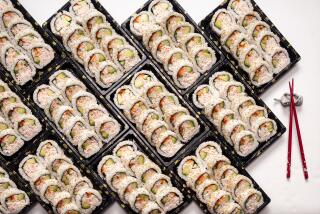No Crab
- Share via
Dungeness crab is a West Coast tradition for the Christmas season and, it seems, so is a rocky start for the crab harvest. This year has already seen one strike by crabbers and, it appears, another has started.
It’s not that crabbers are unusually cranky, it’s more that the economic mechanism used to set prices is so unusual. With most products, seafood or otherwise, the price is set after the material has been harvested. That way, producers and consumers know the quality and the quantity involved.
With crabs, it’s different. Crabbers and processors agree on prices before the crab pots are even in the water, before either knows how many or of what quality the crabs will be.
“It’s part of the tradition of crabbing,” says Jerry Thomas, president of Eureka Fisheries, one of California’s larger processors of Dungeness crab. “We as processors are buying product from fishermen, not really knowing what the quality is. And we certainly don’t know what the quantity will be. We try to make a guesstimate, but we agree to buy kind of not knowing what the situation is.
“It’s equally tough for fishermen. They don’t know what the quality or quantity is either. If there is less crab than anticipated, the fishermen probably could have gotten a little more money for their product. And they definitely need it. Their costs are pretty fixed--their boat payments, their labor, their fuel--those are all the same whether they catch a little crab or a lot.”
If an agreement on price can’t be reached, the crabbers stay in port. That’s what apparently has happened this year. But after fishers agreed on prices after an earlier strike, Thomas says, fishing has stopped again. The recent bad weather is partly to blame. “But there’s something else going on and I don’t know what it is,” Thomas says. “And I’ve got to tell you, I’m getting pretty frustrated.”
When the first strike ended, Dungeness crab prices, which had been $3.50 per pound and up, dropped to $2.99 and less, with specials about $1.99 a pound. The current strike does not seem to have moved retail prices from that point.
The catch in Oregon and Washington had gotten off to a late start even before the first strike. Early sampling of the crab populations there showed that the crabs were not at a place in their natural cycle where they were at their best, so the harvest, which typically starts Dec. 1, didn’t get going until last Saturday. Crabs caught before the second strike looked to be filling out better.
“Right after they molt, crabs have less meat than they will later,” says Rob Ross, executive director of the California Fisheries and Seafood Institute. “They’re like football players three months before the season--they haven’t bulked up yet.”
Once they have bulked up, Dungeness crabs are the defensive linemen of the seafood world, roughly a quarter of their weight being meat. That compares to the lightweight East Coast blue crabs, which average around 15% meat. The average crab weighs 1 1/2 to 2 pounds, so figure roughly a third- to a half-pound pound of meat per crab.
More to Read
Sign up for The Wild
We’ll help you find the best places to hike, bike and run, as well as the perfect silent spots for meditation and yoga.
You may occasionally receive promotional content from the Los Angeles Times.







